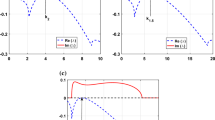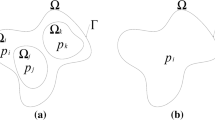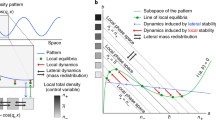Abstract
Turing instabilities for a two species reaction-diffusion system is studied under anisotropic diffusion. More specifically, the diffusion constants which characterize the ability of the species to relocate in space are direction sensitive. Under this working hypothesis, the conditions for the onset of the instability are mathematically derived and numerically validated. Patterns which closely resemble those obtained in the classical context of isotropic diffusion, develop when the usual Turing condition is violated, along one of the two accessible directions of migration. Remarkably, the instability can also set in when the activator diffuses faster than the inhibitor, along the direction for which the usual Turing conditions are not matched.
Similar content being viewed by others
References
J.D. Murray, Mathematical Biology II: Spatial Models and Biomedical Applications (Springer-Verlag, 2003)
A. Ord, B.E. Hobbs, Phil. Trans. R. Soc. A 368, 95 (2010)
B.P. Belousov, Collection of Abstracts on Radiation Medicine 145, 147 (1957)
S. Strogatz, Non linear dynamics and chaos: with applications to Physics, Biology, Chemistry and Engineering (Perseus Book Group, 2001)
L. Yang, M. Dolnik, A.M. Zhabotinsky, E.R. Epstein, J. Chem. Phys. 117, 7259 (2002)
R. deForest, A. Belmonte, Phys. Rev. E. 87, 062138 (2013)
M.A. Novak, R.M. May, Nature 359, 827 (1992)
M.A. Novak, S. Bonhoeffer, R.M. May, Int. J. Bifurc. Chaos 4, 33 (1993)
J.Y. Wakano, Ch. Hauert, J. Theor. Biol. 268, 30 (2011)
A.M. Turing, Phil. Trans. R. Soc. London Ser. B 237, 37 (1952)
R.A. Satnoianu, M. Menzinger, P.K. Maini, Math. Biol. 41, 493 (2000)
B. Ermentrout, M. Lewis, Bull. Math. Biol. 59, 533 (1997)
M. Asslani, F. Di Patti, D. Fanelli, Phys. Rev. E 86, 046105 (2012)
M. Asllani, T. Biancalani, D. Fanelli, A.J. McKane, Eur. Phys. J. B 86, 476 (2013)
T. Biancalani, F. Di Patti, D. Fanelli, Phys. Rev. E 81, 046215 (2010)
L. Cantini, C. Cianci, D. Fanelli, E. Massi, L. Barletti, M. Asllani, J. Math. Biol. 69, 1585 (2014)
C. Varea, J.L. Aragón, R.A. Barrio, Phys. Rev. E 60, 4588 (1999)
D. del-Castillo-Negrete, B.A. Carreras, V. Lynch, Physica D 168-169, 45 (2002)
G. Mulone, S. Rionero, W. Wang, Nonlin. Anal. 74, 4831 (2011)
A.E. Tikhomirova, V.A. Volpert, Appl. Math. Lett. 20, 163 (2007)
M.A. Tsyganov, J. Brindley, A.V. Holden, V.N. Biktashev, Phys. Rev. Lett. 91, 218102 (2003)
V.K. Vanag, I.R. Epstein, Phys. Chem. Chem. Phys. 11, 897 (2009)
T.C. Lacalli, D.A. Wilkinson, L.G. Harrison, Development 103, 105 (1988)
H. Shoji, Y. Iwasa, A. Mochizuki, S. Kondo, J. Theor. Biol. 214, 549 (2002)
D. Fanelli, A. McKane, Phys. Rev. E 82, 021113 (2010)
D. Fanelli, C. Cianci, F. Di Patti, Eur. Phys. J. B 86, 142 (2013)
G. Gambino, M.C. Lombardo, M. Sammartino, Math. Comput. Simul. 82, 1112 (2012)
S. Kovács, Nonlin. Anal. 59, 567 (2004)
N. Kumar, W. Horsthemke, Phys. Rev. E 83, 036105 (2011)
R. Ruiz-Baier, C. Tian, Nonlin. Anal. 14, 601 (2013)
E.P. Zemskov, V.K. Vanag, I.R. Epstein, Phys. Rev. E 84, 036216 (2011)
E.P. Zemskov, K. Kassner, M.J.B. Hauser, W. Horsthemke, Phys. Rev. E 87, 032906 (2013)
S.P. Dawson, A. Lawniczak, R. Kapral, J. Chem. Phys. 100, 5211 (1994)
A.B. Rovinsky, M. Menzinger, Phys. Rev. Lett. 69, 1193 (1992)
D.A. Vasquez, J.W. Wilder, B.F. Edwards, Phys. Rev. Lett. 71, 1538 (1993)
F. Mertens et al., Phys. Rev. E 51, R5193 (1995)
M. Mimura, J.D. Murray, J. Theor. Biol. 75, 249 (1978)
Author information
Authors and Affiliations
Corresponding author
Rights and permissions
About this article
Cite this article
Busiello, D., Planchon, G., Asllani, M. et al. Pattern formation for reactive species undergoing anisotropic diffusion. Eur. Phys. J. B 88, 222 (2015). https://doi.org/10.1140/epjb/e2015-60269-0
Received:
Revised:
Published:
DOI: https://doi.org/10.1140/epjb/e2015-60269-0




